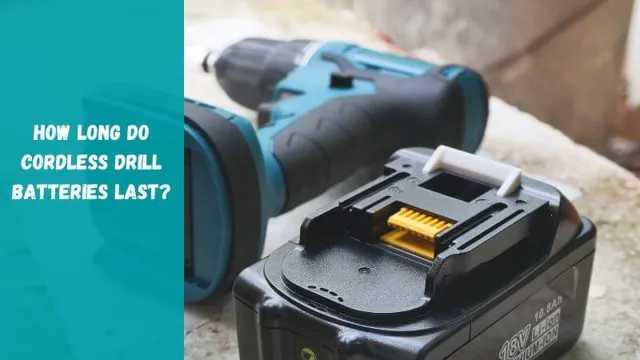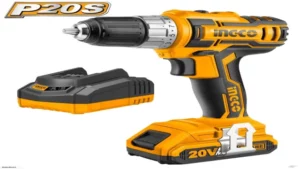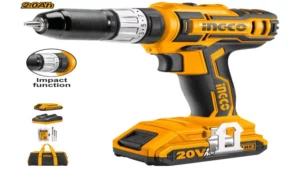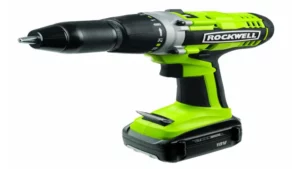There’s nothing more frustrating than being in the middle of a DIY project and having your trusty cordless drill battery die on you. But just how long do cordless drill batteries last? The short answer is that it depends on several factors, including the type of battery, the quality of the battery, and how often you use your drill. Lithium-ion batteries are the most common battery type for cordless drills, and they typically last anywhere from one to three years, depending on usage.
Cheaper, lower-quality batteries may need to be replaced more often, while higher-quality batteries can last up to five years or more with proper maintenance. But it’s not just about the battery itself. How often you charge and use your drill can also impact its battery life.
Proper charging habits can extend the life of your battery, while overuse or underuse can cause it to deteriorate more quickly. In this blog, we’ll explore the ins and outs of cordless drill batteries, from factors that impact their lifespan to tips for keeping them running smoothly. Whether you’re a DIY enthusiast or a professional contractor, understanding how long your cordless drill battery will last can help you plan ahead and avoid unexpected hiccups in your projects.
So, let’s get started!
Factors That Affect Cordless Drill Battery Life
Cordless drill batteries are incredibly convenient, allowing you to work on any project without being tethered to an outlet, but how long do they last? Well, that depends on a few key factors. The first is the type and quality of the battery itself. Lithium-ion batteries tend to last longer than NiCad batteries and can withstand more charging cycles.
The second is how often you use your drill and how long you use it for. If you frequently use your drill for extended periods, you may need to replace the battery sooner than if you only use it occasionally for short periods. The third factor is how well you take care of your battery.
If you store it properly and avoid exposing it to extreme temperatures or moisture, it will last longer. Finally, using the right charger designed for your specific battery can also extend its lifespan. Ultimately, with proper care and usage, your cordless drill battery should last several years before needing replacement.
Type of Battery
When it comes to cordless drill battery life, there are a few factors to consider. One of the most important factors is the type of battery. There are two main types of batteries used in cordless drills: nickel-cadmium (NiCad) and lithium-ion (Li-ion).
NiCad batteries are less expensive than Li-ion batteries, but they are heavier and have a shorter lifespan. They also suffer from the “memory effect,” which means that if they are not fully discharged before being recharged, they will start to lose their capacity. On the other hand, Li-ion batteries are lighter, have a longer lifespan, and do not suffer from the memory effect.
However, they are more expensive than NiCad batteries. Another factor that affects cordless drill battery life is the temperature. Extreme heat or cold can reduce the battery’s performance and lifespan.
It is best to store batteries in a cool, dry place and avoid exposing them to temperatures above 120°F or below 32°F. Using the right charger for your battery is also important. Using a charger that is not designed for your battery can lead to overcharging, which can damage the battery and reduce its lifespan.
It is best to stick to the charger that came with your cordless drill. In conclusion, understanding the type of battery, temperature, and charger compatibility can significantly impact the lifespan of your cordless drill’s battery. Whether you are a professional or a DIYer, taking these factors into consideration can save you time, money, and frustration in the long run.
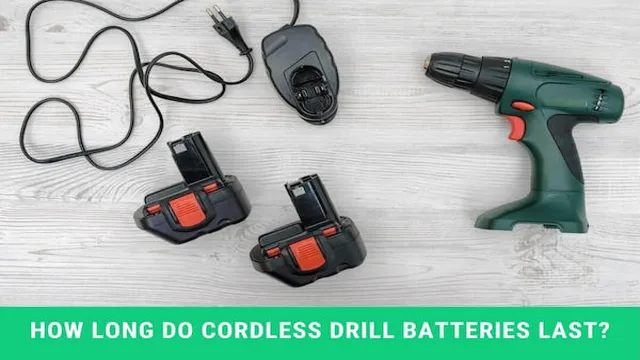
Battery Capacity
When it comes to cordless drill batteries, the battery capacity is crucial. The capacity is measured in ampere-hours (Ah) and refers to the amount of energy the battery can store. A higher capacity means a longer runtime, which is essential for completing jobs without interruptions.
However, there are various factors that can affect the battery’s life. For instance, high temperatures can reduce the battery’s capacity and cause the battery to degrade faster. Similarly, storing the battery for extended periods without charging it can also reduce the battery’s overall capacity.
Furthermore, using the drill for intensive tasks can quickly drain the battery, reducing its overall runtime. Therefore, it is essential to consider these factors to ensure that your cordless drill battery lasts longer and performs better.
You May Also Love:
Usage Frequency
Cordless drills have become a staple of modern-day tool collections, making DIY projects easier than ever before. However, the battery life of cordless drills can vary depending on several factors. One of the most significant factors that affect cordless drill battery life is usage frequency.
The more you use your cordless drill, the more likely its battery will gradually lose its capacity to hold a charge over time. Moreover, consistently draining your battery without allowing it to recharge fully can significantly reduce its lifespan. To ensure your cordless drill’s battery lasts as long as possible, it’s essential to be mindful of how often you use it and to follow the manufacturer’s charging and discharging guidelines.
Additionally, purchasing a high-quality battery with a higher capacity can also extend the battery life of your cordless drill. So, whether you’re a professional contractor or a DIY enthusiast, being mindful of usage frequency can help you get the most out of your cordless drill’s battery.
Charging Habits
When it comes to cordless drill battery life, charging habits play a crucial role. Factors like how often you charge the battery, how long you leave it on the charger, and whether you fully discharge it before recharging can all impact the lifespan of your battery. For instance, frequent charging without fully discharging can lead to a phenomenon called “memory effect,” which means the battery gradually loses its ability to store a charge.
On the other hand, leaving your battery on the charger for extended periods can lead to overcharging, which can damage the battery and shorten its lifespan. To extend your cordless drill battery’s life, it’s best to charge it only when it’s nearly empty and unplug it as soon as it’s fully charged. Additionally, refrain from using fast chargers as they generate more heat, which can also affect your battery’s health negatively.
By using the right charging habits, you can ensure that your cordless drill battery lasts as long as possible and avoid costly replacements in the future.
Average Lifespan of Cordless Drill Batteries
If you own a cordless drill, you may be wondering how long the battery will last before you need to replace it. The average lifespan of a cordless drill battery depends on a variety of factors such as the brand, model, and usage frequency. Generally, most cordless drill batteries last between one and three years, but with proper care and maintenance, some can last up to five years.
It’s important to keep in mind that the battery’s lifespan will decrease over time as it’s charged and discharged repeatedly. To maximize the lifespan of your cordless drill battery, avoid overcharging, store it in a cool, dry place, and use the proper charger recommended by the manufacturer. Additionally, it’s wise to invest in a backup battery to ensure you have enough power to complete your projects without any interruptions.
So, if you’re asking yourself “how long do cordless drill batteries last?”, the answer depends on how well you take care of it.
NiCad Batteries
As users of cordless drills, one of the most important things to consider is the lifespan of the NiCad batteries that provide their power. On average, cordless drill batteries tend to last anywhere between 2 and 5 years, though some have been known to last longer with proper care and maintenance. However, it’s worth noting that heavy use and exposure to extreme temperatures can often shorten their lifespan significantly.
To get the most out of your batteries, be sure to properly charge and store them, avoid overloading the drill, and use them only when needed. With proper care, your batteries should last you for several years, allowing you to get the most out of your trusty cordless drill. So go ahead, tackle those DIY projects with confidence!
Lithium-ion Batteries
Lithium-ion batteries are commonly used in cordless power tools like drills, providing a long-lasting and powerful energy source. However, like any battery, they do have a limited lifespan. On average, a cordless drill battery will last about two to three years with regular use.
Factors that can affect the lifespan of a lithium-ion battery include how often it is charged, how it is stored when not in use, and the temperature of the environment. Over time, the battery will lose its ability to hold a charge and will need to be replaced. If you want to prolong the lifespan of your cordless drill battery, it’s essential to follow the manufacturer’s instructions for charging and storage.
For example, avoid overcharging the battery and store it in a cool, dry place away from direct sunlight. Proper care and maintenance will help ensure that your cordless drill battery lasts as long as possible, keeping your power tools running efficiently when you need them most.
Maximizing the Lifespan of Cordless Drill Batteries
Cordless drill batteries are an essential tool for handymen and house owners. They come in handy when working on projects that require a power source without the hassle of cords. However, they may not last as long as you would want them to.
The lifespan of cordless drill batteries is determined by several factors. These include the type of battery, frequency of use, how it is stored, and the chargers used. Typically, lithium-ion batteries last longer than nickel-cadmium batteries, but they are more expensive.
Using the right charger for your battery type can also increase its lifespan. To ensure your battery lasts longer, store them in a cool and dry place and avoid overcharging them. It is also advisable to charge your battery after use and not before.
These simple steps can make a significant difference in how long your cordless drill battery lasts, saving you money and time in replacements.
Proper Storage
Proper storage is key to maximizing the lifespan of your cordless drill batteries. Many people mistakenly think that leaving their batteries on the charger all the time will keep them at full capacity, but this can actually have the opposite effect. Overcharging can lead to diminished battery capacity over time.
It’s best to store batteries at room temperature in a dry place, ideally in a case or holder designed specifically for your drill model. Avoid exposing them to extreme temperatures or moisture, as this can cause damage to the battery cells and shorten their lifespan. Keeping your batteries in good condition will not only save you money in the long run, but will also ensure that your cordless drill is always ready when you need it.
Maintenance Tips
As cordless drill batteries are an indispensable part of our daily lives, it is essential to be mindful of their maintenance. This can go a long way in maximizing the lifespan of your cordless drill batteries. One of the most important tips to follow is proper charging and discharging.
It is suggested to avoid overcharging the battery as it can lead to decreased battery life. Also, don’t run the battery completely down before recharging. It is best to charge it before it drops below 20% battery life.
Another useful tip is to store your battery in a cool and dry place as high temperature and humidity can lead to battery failure. Additionally, it is recommended to clean the contacts and terminals of the battery regularly to facilitate better connection and power flow. By following these simple maintenance tips, you can make your cordless drill batteries last longer and save money in the long run.
Conclusion
In summary, the lifespan of cordless drill batteries varies greatly depending on various factors such as usage frequency, maintenance, and quality. Much like the length of a piece of string, there is no definitive answer to how long cordless drill batteries last. However, with proper care and attention, they can power through many DIY projects and be a reliable companion in your tool arsenal.
“
FAQs
How long do cordless drill batteries last?
The lifespan of the battery depends on factors such as usage frequency, charging habits, and storage conditions. Typically, cordless drill batteries can last anywhere from 2 to 4 years.
Can I replace the battery in my cordless drill?
Yes, most cordless drill batteries are replaceable. You can purchase a replacement battery from the manufacturer or a third-party supplier.
How can I extend the life of my cordless drill battery?
To extend the life of your cordless drill battery, make sure to fully charge and discharge the battery at least once a month, store it in a cool and dry place, and avoid overcharging or undercharging the battery.
What is the difference between a nickel-cadmium battery and a lithium-ion battery?
Nickel-cadmium batteries are known for their durability and long lifespan, but they are heavier and contain toxic chemicals. Lithium-ion batteries, on the other hand, are lighter and more energy-efficient, but they can be more expensive and have a shorter lifespan.
How long does it take to fully charge a cordless drill battery?
The charging time for cordless drill batteries varies depending on the battery type and capacity. On average, it can take anywhere from 30 minutes to 2 hours to fully charge a cordless drill battery.
Can I use my cordless drill while the battery is charging?
Most cordless drills are designed to be used while the battery is charging. However, it’s important to check the manufacturer’s instructions to ensure that it’s safe to use your particular model while charging.
What should I do with my old cordless drill batteries?
It’s important to recycle your old cordless drill batteries to prevent toxic chemicals from entering the environment. Many retailers and recycling facilities offer battery recycling programs, so be sure to check with your local recycling center or hardware store to find the nearest recycling location.
